-
 This April release was produced in a quantity of 4,550 units. Wayne Neyens designed the machine with Roy Parker doing the artwork. The art theme of the machine is Playboy bunnies as the Playboy Corporation opened a big Playboy club in the Chicago area in 1960 which was a real hit. The object of the game is to light the bumpers spelling out “Slick Chick.” It’s a tough game to master. Each time the sequence is completed, a rollover lights on the play field to score 10 points. If you can complete all five roll-overs, the center gobble hole lights to score a replay. Four roll-overs on the side of the play field numbered one to four also score a replay if hit in sequence. Score is your other goal toward replays. I remember playing this game at the arcades and it was very hard to achieve a winning combination. It is considered one of Wayne Neyens’ best games and one of his favorites in the annals of pinball design.
This April release was produced in a quantity of 4,550 units. Wayne Neyens designed the machine with Roy Parker doing the artwork. The art theme of the machine is Playboy bunnies as the Playboy Corporation opened a big Playboy club in the Chicago area in 1960 which was a real hit. The object of the game is to light the bumpers spelling out “Slick Chick.” It’s a tough game to master. Each time the sequence is completed, a rollover lights on the play field to score 10 points. If you can complete all five roll-overs, the center gobble hole lights to score a replay. Four roll-overs on the side of the play field numbered one to four also score a replay if hit in sequence. Score is your other goal toward replays. I remember playing this game at the arcades and it was very hard to achieve a winning combination. It is considered one of Wayne Neyens’ best games and one of his favorites in the annals of pinball design. -

-

-
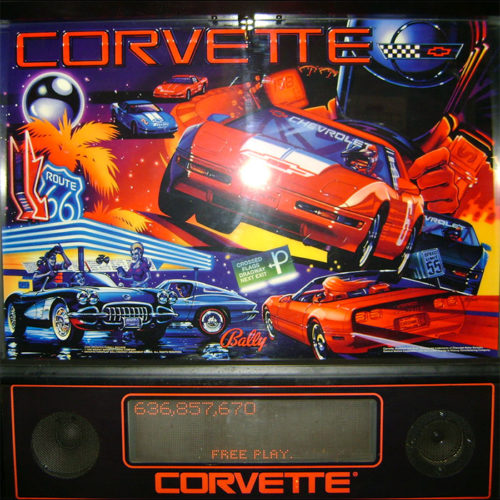
-
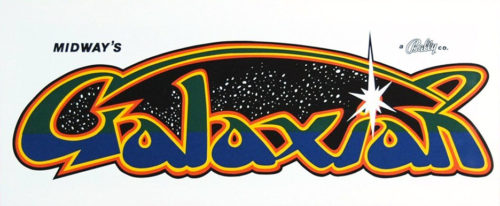 Galaxian (Gyarakushian?) is an arcade game that was developed by Namco and released in October 1979. It was published by Namco in Japan and imported to North America by Midway that December. A fixed shooter game in which the player controls a spaceship at the bottom of the screen, and shoots enemies descending in various directions, it was designed to compete with Taito Corporation’s successful earlier game Space Invaders (which was released in the previous year, and also imported to the US by Midway Games). The game was highly popular for Namco upon its release, and has been a focus of competitive gaming ever since. It spawned a successful sequel, Galaga, in 1981, and the lesser known Gaplus and Galaga ‘88 in 1984 and 1987 respectively, as well as many later ports and adaptations. Along with its immediate sequel, it was one of the most popular games during the golden age of arcade video games. Galaxian expanded on the formula pioneered by Space Invaders. As in the earlier game, Galaxian features a horde of attacking aliens that exchanged shots with the player. In contrast to Space Invaders, Galaxian added an element of drama by having the aliens periodically make kamikaze-like dives at the player’s ship, the Galaxip.[1] This made it the first game to feature enemies with individual personalities.[2] The game’s plot consists of a title screen that displayed the message “WE ARE THE GALAXIANS / MISSION: DESTROY ALIENS”.[3] Galaxian was very successful for Namco and introduced several “firsts”. Although not the first color video game, Galaxian took RGB color graphics a step further with multi-colored animated sprites and explosions, different colored fonts for the score and high score, the scrolling starfield, and graphic icons that show the number of lives left and how many stages the player had completed. It also features a crude theme song and more prominent background “music.” These elements combine to create a look and feel that would set the standard for arcade games in the 1980s such as Pac-Man. Gameplay The gameplay is relatively simple. Swarm after swarm of alien armies attack the player’s ship that moves left and right at the bottom of the wraparound screen. The ship can only have one shot on screen at a time. The player defeats one swarm, only to have it replaced by another more aggressive and challenging swarm in the next stage. A plain and repetitive starfield scrolls in the background.
Galaxian (Gyarakushian?) is an arcade game that was developed by Namco and released in October 1979. It was published by Namco in Japan and imported to North America by Midway that December. A fixed shooter game in which the player controls a spaceship at the bottom of the screen, and shoots enemies descending in various directions, it was designed to compete with Taito Corporation’s successful earlier game Space Invaders (which was released in the previous year, and also imported to the US by Midway Games). The game was highly popular for Namco upon its release, and has been a focus of competitive gaming ever since. It spawned a successful sequel, Galaga, in 1981, and the lesser known Gaplus and Galaga ‘88 in 1984 and 1987 respectively, as well as many later ports and adaptations. Along with its immediate sequel, it was one of the most popular games during the golden age of arcade video games. Galaxian expanded on the formula pioneered by Space Invaders. As in the earlier game, Galaxian features a horde of attacking aliens that exchanged shots with the player. In contrast to Space Invaders, Galaxian added an element of drama by having the aliens periodically make kamikaze-like dives at the player’s ship, the Galaxip.[1] This made it the first game to feature enemies with individual personalities.[2] The game’s plot consists of a title screen that displayed the message “WE ARE THE GALAXIANS / MISSION: DESTROY ALIENS”.[3] Galaxian was very successful for Namco and introduced several “firsts”. Although not the first color video game, Galaxian took RGB color graphics a step further with multi-colored animated sprites and explosions, different colored fonts for the score and high score, the scrolling starfield, and graphic icons that show the number of lives left and how many stages the player had completed. It also features a crude theme song and more prominent background “music.” These elements combine to create a look and feel that would set the standard for arcade games in the 1980s such as Pac-Man. Gameplay The gameplay is relatively simple. Swarm after swarm of alien armies attack the player’s ship that moves left and right at the bottom of the wraparound screen. The ship can only have one shot on screen at a time. The player defeats one swarm, only to have it replaced by another more aggressive and challenging swarm in the next stage. A plain and repetitive starfield scrolls in the background. -
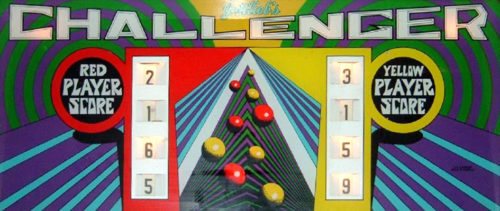 Here is one you do not see every day. This is a Gottlieb Challenger from 1971. Only 110 of these were produced back in the day. How many are still around now … head-to-head pinball game with two players at opposite ends of the playfield, simultaneous soccer like play, can not be played with one player. Each player has flipper buttons which control only those flippers facing the opponent. Ball enters play from between the flippers. Game has 8 flippers and vertically mounted score reels. The playfield actually tilts towards and away from the players, depending on which end served the ball.
Here is one you do not see every day. This is a Gottlieb Challenger from 1971. Only 110 of these were produced back in the day. How many are still around now … head-to-head pinball game with two players at opposite ends of the playfield, simultaneous soccer like play, can not be played with one player. Each player has flipper buttons which control only those flippers facing the opponent. Ball enters play from between the flippers. Game has 8 flippers and vertically mounted score reels. The playfield actually tilts towards and away from the players, depending on which end served the ball. -
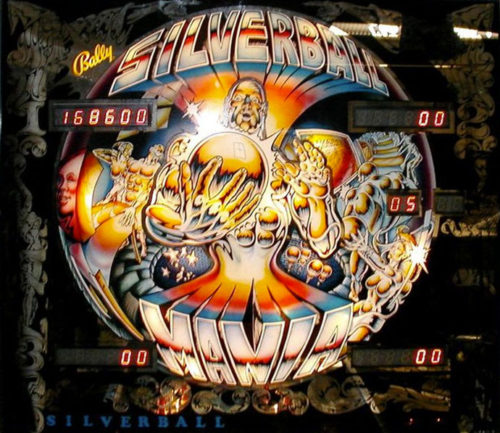 10,350 of these machines made it through the doors of Bally in 1978. Designed by the great Jim Patla and art package by Kevin O’Conner, this early wide body machine is a perfect match for the pinball trade as well as this museum. Even though it was made prior to vocalization in pinball machines, the sounds of the machine draw one in to play its features. All the technology of the 70s is present here with drop targets, loop shots, advancing bonus features and a novel kick back kicker between the flippers which, once achieved, brings the ball back into play instead of draining. Completing the spelling of “Silverball Mania” advances the bonus features. If you complete this feat three times in a game, a built in carrier feature advances on the backglass and awards an operator-adjustable reward, classically three free games. A great playfield flow was designed into the game with two “back to the top” shots enticing players along.
10,350 of these machines made it through the doors of Bally in 1978. Designed by the great Jim Patla and art package by Kevin O’Conner, this early wide body machine is a perfect match for the pinball trade as well as this museum. Even though it was made prior to vocalization in pinball machines, the sounds of the machine draw one in to play its features. All the technology of the 70s is present here with drop targets, loop shots, advancing bonus features and a novel kick back kicker between the flippers which, once achieved, brings the ball back into play instead of draining. Completing the spelling of “Silverball Mania” advances the bonus features. If you complete this feat three times in a game, a built in carrier feature advances on the backglass and awards an operator-adjustable reward, classically three free games. A great playfield flow was designed into the game with two “back to the top” shots enticing players along. -
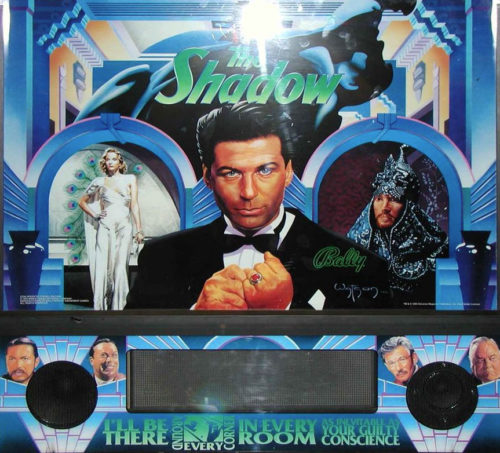 This machine is based on the ’30s radio series then turned into a movie. Design accolades go to Brian Eddy with art scripted by Doug Watson. 4,247 of these machines were made. The interesting feature in this machine is the elevated upper-left playfield. This playfield is gained access to once the drop target is hit. Once this challenge is complete, another shot to this ramp shoots the ball upstairs to this feature. Pressing the flipper buttons moves the paddle left or right. The kicker is activated by an optic sensor automatically to hit all the targets if your aim is sure. This game also has a thrust magnet which grabs the ball in action and shoots it up the playfield into the next feature. No pop bumpers are on the playfield, which is a rare event. Another first incorporated into this playfield are two ramp diverters which are player adjustable. Completing the six scenes of the story award you with the final battle sequence of good against evil.
This machine is based on the ’30s radio series then turned into a movie. Design accolades go to Brian Eddy with art scripted by Doug Watson. 4,247 of these machines were made. The interesting feature in this machine is the elevated upper-left playfield. This playfield is gained access to once the drop target is hit. Once this challenge is complete, another shot to this ramp shoots the ball upstairs to this feature. Pressing the flipper buttons moves the paddle left or right. The kicker is activated by an optic sensor automatically to hit all the targets if your aim is sure. This game also has a thrust magnet which grabs the ball in action and shoots it up the playfield into the next feature. No pop bumpers are on the playfield, which is a rare event. Another first incorporated into this playfield are two ramp diverters which are player adjustable. Completing the six scenes of the story award you with the final battle sequence of good against evil. -

-
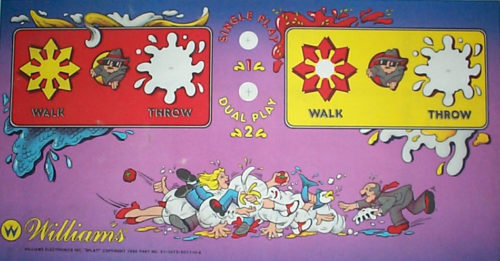
-
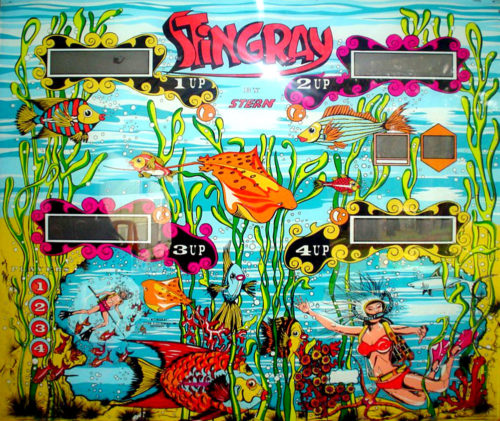 Here’s a 1977 Stern ‘Pinball’. This was Stern’s first solid state machine and marked the beginning of a long and interesting history for the company. Designed by Mike Kubin, it’s a fast game that has some wicked out-lanes and very quick ball times. There are no mini-posts above the out-lane guides which make controlling the ball near the out-lanes very difficult. Stingray, the game made by Stern following ‘Pinball’ also lacked these posts, but games made thereafter had the posts which dramatically improve the player’s ability to control the ball and avoid the out-lane. This game has a basic rule-set. Knock down the 5 drop targets twice in one ball to score the special. The saucer on the right side of the playfield awards a somewhat random award and the spinner shot on the left is a very satisfying shot to hit.
Here’s a 1977 Stern ‘Pinball’. This was Stern’s first solid state machine and marked the beginning of a long and interesting history for the company. Designed by Mike Kubin, it’s a fast game that has some wicked out-lanes and very quick ball times. There are no mini-posts above the out-lane guides which make controlling the ball near the out-lanes very difficult. Stingray, the game made by Stern following ‘Pinball’ also lacked these posts, but games made thereafter had the posts which dramatically improve the player’s ability to control the ball and avoid the out-lane. This game has a basic rule-set. Knock down the 5 drop targets twice in one ball to score the special. The saucer on the right side of the playfield awards a somewhat random award and the spinner shot on the left is a very satisfying shot to hit. -
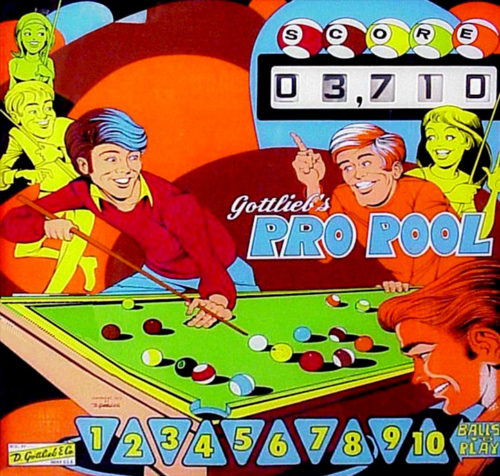 Pro Pool originated in December with 800 units being fabricated. This add-a-ball machine was designed by Ed Krynski with artwork by Gordon Morison. Two replay versions of the game were also made: a two-player version called Big Shot and a four-player version called Hot Shot. Obviously the theme of this game is the game of pool. The playfield is symmetrical and the way to win extra balls is by completing the left and/or right drop target battery. Doing so will lift the left and/or right wow rollovers for this award. The drop targets reset once the sequences are completed. Of course, an operator-adjusted score is another way to score a couple of balls. Back in the ‘70s, multiple balls or replays could be achieved on the game. Today, one free game on a current solid-state game is the common win. Operators have made it harder to achieve free games today as free games yield no income and only result in down time for the machine to earn coins in the till.
Pro Pool originated in December with 800 units being fabricated. This add-a-ball machine was designed by Ed Krynski with artwork by Gordon Morison. Two replay versions of the game were also made: a two-player version called Big Shot and a four-player version called Hot Shot. Obviously the theme of this game is the game of pool. The playfield is symmetrical and the way to win extra balls is by completing the left and/or right drop target battery. Doing so will lift the left and/or right wow rollovers for this award. The drop targets reset once the sequences are completed. Of course, an operator-adjusted score is another way to score a couple of balls. Back in the ‘70s, multiple balls or replays could be achieved on the game. Today, one free game on a current solid-state game is the common win. Operators have made it harder to achieve free games today as free games yield no income and only result in down time for the machine to earn coins in the till. -
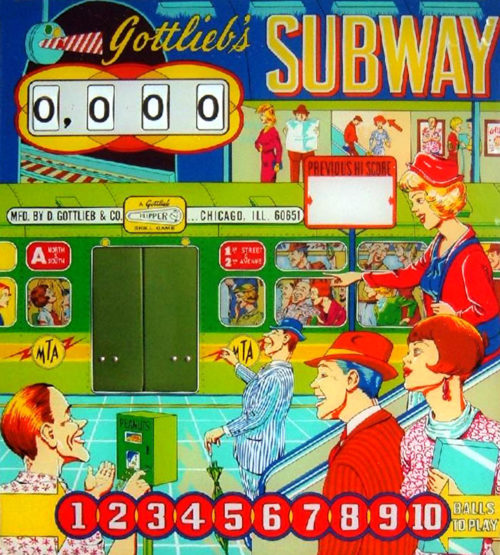 Gottlieb Subway arrived in October ’66. It was designed by the classic team of Ed Krynski and art by Gordon Morison. This add-a-ball version of the game closely resembled the replay version by the name of Crosstown. This wedgehead Gottlieb has an animated backglass. Every time 100 points are scored, the door of the subway opens, revealing passengers jammed together in a comical pose. The center target is where all the action is in the game. If you happened to match the two columns horizontally by advancing the columns by hitting various spots on the game and hit the center target, the award indicated would be given. Otherwise 10 points were awarded. This game was a tough game to play, as the opening between the flippers was rather large and a hit to the center target would regularly cost you a lost ball.
Gottlieb Subway arrived in October ’66. It was designed by the classic team of Ed Krynski and art by Gordon Morison. This add-a-ball version of the game closely resembled the replay version by the name of Crosstown. This wedgehead Gottlieb has an animated backglass. Every time 100 points are scored, the door of the subway opens, revealing passengers jammed together in a comical pose. The center target is where all the action is in the game. If you happened to match the two columns horizontally by advancing the columns by hitting various spots on the game and hit the center target, the award indicated would be given. Otherwise 10 points were awarded. This game was a tough game to play, as the opening between the flippers was rather large and a hit to the center target would regularly cost you a lost ball. -
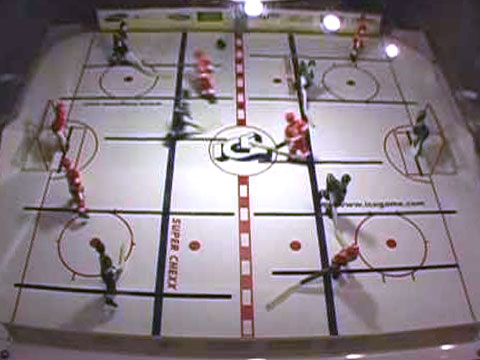 Super Chexx is a table hockey arcade game manufactured by Innovative Concepts in Entertainment (ICE).[1] ICE began manufacturing these in 1982 and continues production to this day in Clarence, New York just outside of Buffalo. These types of games are also known as bubble hockey, rod hockey, table hockey or dome hockey because of the long rods used to control the players and the distinctive dome or “bubble” covering the playing field. The game can be played by two opposing players who control all five hockey players and the goalie for their side (singles) or as a two on two game (doubles). Players control their five skaters with long rods that move in and out to bring skaters up and down the ice and spin 360 degrees. A knob is used to move the goalie from side to side. Each player also a “boo button” to simulate sounds from the crowd. Vintage versions of Super Chexx feature the USA vs. Russia, Canada vs. Russia, or USA vs. Canada formats. In 2010 ICE introduced a Deluxe Home version of the game with no coin doors and started offering NHL and AHL licensed team versions. There is also a 30th Anniversary “Miracle on Ice” Edition of the game featuring the classic USA vs CCCP teams licensed through USA Hockey. Licensed games feature team colors and logos with custom hand-painted players in replica jerseys. The early versions of the game were made with blue bases, but most of the games are now made with red bases. The first black bases were made for a Bubble Boys Tournament with Wayne Gretzky and Bud Light in 1999. There was a limited edition of 100 games with black bases made in 2005. A further limited edition with the black base was made in 2007. The home version of the game has a base which can be split and hinged to fit through narrow doorways and comes in red or black.
Super Chexx is a table hockey arcade game manufactured by Innovative Concepts in Entertainment (ICE).[1] ICE began manufacturing these in 1982 and continues production to this day in Clarence, New York just outside of Buffalo. These types of games are also known as bubble hockey, rod hockey, table hockey or dome hockey because of the long rods used to control the players and the distinctive dome or “bubble” covering the playing field. The game can be played by two opposing players who control all five hockey players and the goalie for their side (singles) or as a two on two game (doubles). Players control their five skaters with long rods that move in and out to bring skaters up and down the ice and spin 360 degrees. A knob is used to move the goalie from side to side. Each player also a “boo button” to simulate sounds from the crowd. Vintage versions of Super Chexx feature the USA vs. Russia, Canada vs. Russia, or USA vs. Canada formats. In 2010 ICE introduced a Deluxe Home version of the game with no coin doors and started offering NHL and AHL licensed team versions. There is also a 30th Anniversary “Miracle on Ice” Edition of the game featuring the classic USA vs CCCP teams licensed through USA Hockey. Licensed games feature team colors and logos with custom hand-painted players in replica jerseys. The early versions of the game were made with blue bases, but most of the games are now made with red bases. The first black bases were made for a Bubble Boys Tournament with Wayne Gretzky and Bud Light in 1999. There was a limited edition of 100 games with black bases made in 2005. A further limited edition with the black base was made in 2007. The home version of the game has a base which can be split and hinged to fit through narrow doorways and comes in red or black. -
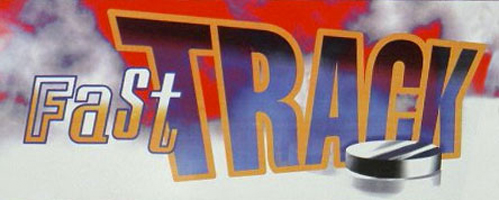
-
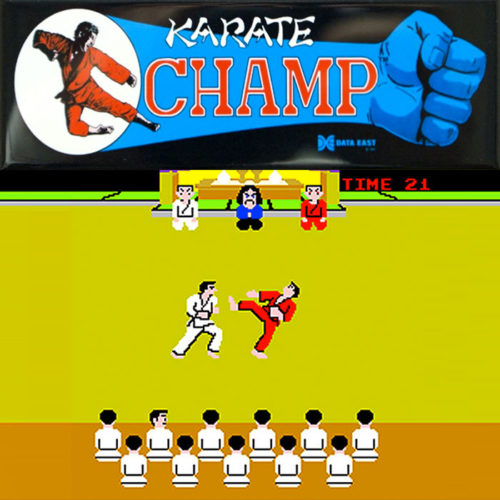
-
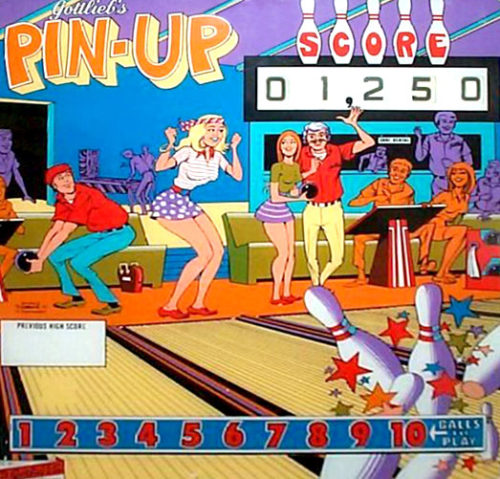 Gottlieb hatched this add-a-ball machine from the skunkworks in April of the year, designed by Ed Krynski and artwork by Gordon Morison. This single-player machine has a bowling theme and only 715 units were produced at that time. The replay version of the game was called King Pin and many more of these machines were produced. The theme of this game is the drop target completion. By carefully aiming the four inherent flippers on board the playfield, one must try to complete the horizontal row of targets. Doing so will reset the targets and the wow feature activates, giving you a shot at the accomplishment of winning extra balls. Score is another way to pop free balls. The ten drop targets are not so easy to complete and the wow feature advances when you roll over the star rollover. This game is challenging, but a beginner can have ample fun with the machine.
Gottlieb hatched this add-a-ball machine from the skunkworks in April of the year, designed by Ed Krynski and artwork by Gordon Morison. This single-player machine has a bowling theme and only 715 units were produced at that time. The replay version of the game was called King Pin and many more of these machines were produced. The theme of this game is the drop target completion. By carefully aiming the four inherent flippers on board the playfield, one must try to complete the horizontal row of targets. Doing so will reset the targets and the wow feature activates, giving you a shot at the accomplishment of winning extra balls. Score is another way to pop free balls. The ten drop targets are not so easy to complete and the wow feature advances when you roll over the star rollover. This game is challenging, but a beginner can have ample fun with the machine. -
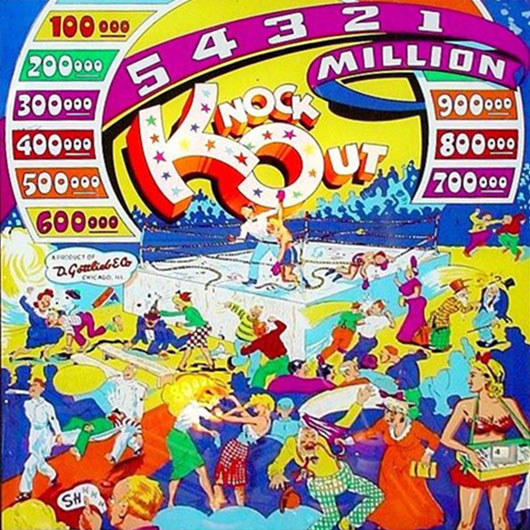 This game was produced in December of the year and designed by Harry Mabs with artwork by Roy Parker. 3,000 of these machines were made. The unique feature built into this machine is the animation unit in the top center of the play field. Two mechanical men are represented as boxers in a boxing match. Lights illuminate the bout when a knockout is scored by rolling over a “KO” rollover, a “KO” target, or completing bumpers 1 to 5. This game is one of the first examples of pinball animation. Another feature of the game is the pop-up bar at the bottom of the play field, preventing you from losing your ball in play for an extended period. Since the gap between the flippers is so massive, this addendum to the play field was installed to prolong the play period of the ball. A special feature is included in the game as well as a replay if 15 knockdowns are scored in one game and a replay for every knockdown scored thereafter.
This game was produced in December of the year and designed by Harry Mabs with artwork by Roy Parker. 3,000 of these machines were made. The unique feature built into this machine is the animation unit in the top center of the play field. Two mechanical men are represented as boxers in a boxing match. Lights illuminate the bout when a knockout is scored by rolling over a “KO” rollover, a “KO” target, or completing bumpers 1 to 5. This game is one of the first examples of pinball animation. Another feature of the game is the pop-up bar at the bottom of the play field, preventing you from losing your ball in play for an extended period. Since the gap between the flippers is so massive, this addendum to the play field was installed to prolong the play period of the ball. A special feature is included in the game as well as a replay if 15 knockdowns are scored in one game and a replay for every knockdown scored thereafter. -
 This machine was produced in january and 7300 copies of it were bolted together. Pat lawlor designed the game with john youssi penning the artwork. The earliest machines in the production run had the chicago cubs logo on the child’s baseball cap but the cubs disallowed its use so the logo was changed. The early examples had a williams logo sticker over the cubs logo. The object of the game is to advance the compass to the north, south , east and west positions. Doing so starts ball lock ..And the “power of the wind” through the use of a dedicated fan on top of the machine to recreate a new physical dimension to your gameplay. Once three balls are locked, the left ramp awards increasing million awards. By earning enough tolls, extra balls may be had. The super cellar value changes via the spinner. Dropping into the cellar awards its value. Another “twist“ in the game’s design is the spinning discs. Tornado action.
This machine was produced in january and 7300 copies of it were bolted together. Pat lawlor designed the game with john youssi penning the artwork. The earliest machines in the production run had the chicago cubs logo on the child’s baseball cap but the cubs disallowed its use so the logo was changed. The early examples had a williams logo sticker over the cubs logo. The object of the game is to advance the compass to the north, south , east and west positions. Doing so starts ball lock ..And the “power of the wind” through the use of a dedicated fan on top of the machine to recreate a new physical dimension to your gameplay. Once three balls are locked, the left ramp awards increasing million awards. By earning enough tolls, extra balls may be had. The super cellar value changes via the spinner. Dropping into the cellar awards its value. Another “twist“ in the game’s design is the spinning discs. Tornado action. -
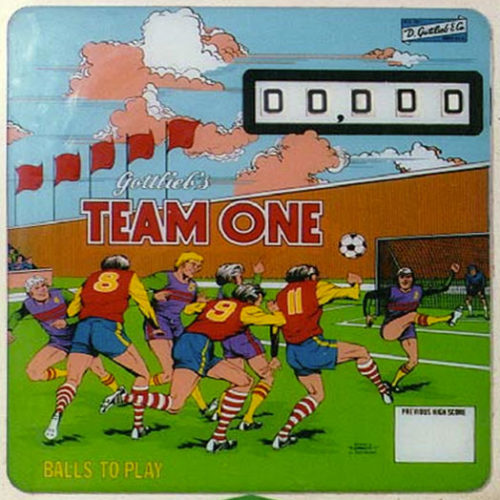
-
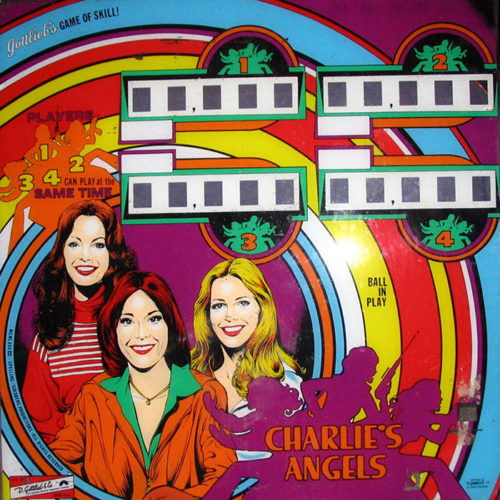
-
 Yet another legendary, genre-defining game – in an era replete with genre-defining classics - in which a single player takes control of a ship trapped in the middle of an asteroid field. A number of large, slow-moving asteroids drift randomly around the play area and must be shot by the player. When shot, the asteroids will break into a number of smaller pieces, which must also be shot until, eventually, all of the asteroids and fragments will be destroyed and the next wave begins. Asteroids introduced real-world physics to video games for the first time, with speed and inertia all adding to the player’s problems. As well as the inertia of the player’s ship – forcing the player to allow for the ship slowing down and speeding up whenever the thrust button was utilized – shot asteroids would often send fragments flying in seemingly random directions, and at varying and unpredictable speeds. As well as the ever-present asteroids, alien saucers also make a regular appearance. These move diagonally around the screen, firing at the player’s ship and must be quickly destroyed.
Yet another legendary, genre-defining game – in an era replete with genre-defining classics - in which a single player takes control of a ship trapped in the middle of an asteroid field. A number of large, slow-moving asteroids drift randomly around the play area and must be shot by the player. When shot, the asteroids will break into a number of smaller pieces, which must also be shot until, eventually, all of the asteroids and fragments will be destroyed and the next wave begins. Asteroids introduced real-world physics to video games for the first time, with speed and inertia all adding to the player’s problems. As well as the inertia of the player’s ship – forcing the player to allow for the ship slowing down and speeding up whenever the thrust button was utilized – shot asteroids would often send fragments flying in seemingly random directions, and at varying and unpredictable speeds. As well as the ever-present asteroids, alien saucers also make a regular appearance. These move diagonally around the screen, firing at the player’s ship and must be quickly destroyed. -
 This Norm Clark and Christian Marsche creation was also produced in an add-a-ball version called Love Bug as well as a four-player version called Dipsy Doodle. This symmetrical playfield design has a captive ball under the playfield which, when activated, rolls over a switch to score a bonus batch of points based on the value of the button when the feature is lit. The top kickout hole randomly selects bonus features to make the game more intriguing. A popup post between the flippers prevents ball drain down the middle of the playfield, but this post may be retracted just at the wrong time if the down-post targets are hit. An extra ball may be achieved if the center target is lit. This target also activates the “doodlebug” under the playfield. Finally, a free ball gate is incorporated into the machine if the appropriate combination of pop bumpers and rollovers are made. A fast-paced game that was popular in its day.
This Norm Clark and Christian Marsche creation was also produced in an add-a-ball version called Love Bug as well as a four-player version called Dipsy Doodle. This symmetrical playfield design has a captive ball under the playfield which, when activated, rolls over a switch to score a bonus batch of points based on the value of the button when the feature is lit. The top kickout hole randomly selects bonus features to make the game more intriguing. A popup post between the flippers prevents ball drain down the middle of the playfield, but this post may be retracted just at the wrong time if the down-post targets are hit. An extra ball may be achieved if the center target is lit. This target also activates the “doodlebug” under the playfield. Finally, a free ball gate is incorporated into the machine if the appropriate combination of pop bumpers and rollovers are made. A fast-paced game that was popular in its day. -
 Claude Fernandez designed this machine at Bally with the infamous Greg Freres penning the artwork early in his career. 4,150 examples of this game were screwed together. This machine’s asymmetrical playfield is classic Bally. Lane change at the top of the playfield via flipping is a first on this machine. By dropping the targets to spell “skate”, one advances the kickout hole to advance. After three or four advances, extra ball and special light. Hitting “skate” and A and B at the bottom of the playfield light extra ball. The center drop targets advance the value of the targets when all lit, all the way to 100,000 points. If you are skillful enough to advance the bonus to its highest point, the specials light up. This Bally game is also the first machine to have seven-digit scoring!
Claude Fernandez designed this machine at Bally with the infamous Greg Freres penning the artwork early in his career. 4,150 examples of this game were screwed together. This machine’s asymmetrical playfield is classic Bally. Lane change at the top of the playfield via flipping is a first on this machine. By dropping the targets to spell “skate”, one advances the kickout hole to advance. After three or four advances, extra ball and special light. Hitting “skate” and A and B at the bottom of the playfield light extra ball. The center drop targets advance the value of the targets when all lit, all the way to 100,000 points. If you are skillful enough to advance the bonus to its highest point, the specials light up. This Bally game is also the first machine to have seven-digit scoring!